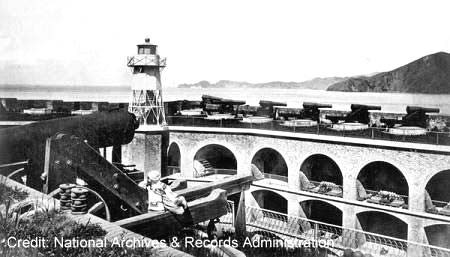Fort Point National Historic Site
Introduction
Text-to-speech Audio
Fort Point in San Francisco, California was built by the United States Army Engineers between 1853 and 1861. At the height of the gold rush, the government felt it needed a bigger presence in the west. The fort was planned to defend the locals from foreign naval attacks. In an attempt to protect the commercial and military buildings nearby, the fort was built with brick and mortar. Its design was to be equal to any fort within the United States.
Images
Fort Point in 1870

Welding shop at Fort Point

Modern day, with the Golden Gate bridge in the background. By Leaflet.

Modern day, inside of the fort. By Dietmar Rabich.

Backstory and Context
Text-to-speech Audio
Colonel Albert Sidney Johnston took command of the Department of the Pacific on December 21, 1860. He ordered the upgrades to the fort and also implemented the first garrison there. Col. Johnston went on to resign from the military to join the Confederate Army on April 9, 1861, once his home state seceded from the Union (Johnston died from bleeding out after a shot in the leg in 1862 at the age of 59). Fort Point's defenses included 141 guns of different types, 55 cannons, and 11 mortars.
Even though the government feared an attack on the fort, one never came. The presence of the fort was possibly one of the reasons why such an attack never happened - it showed the Union had power on the Pacific Coast, and the facilities to protect any assets coming out of the west. With no action during the Civil War and no threat after the war, the fort transitioned into an army barracks. When plans for the Golden Gate Bridge were established there was a worry that the fort would be demolished. Chief Engineer Joseph Strauss realized the value of the fort and ordered the construction of the bridge to take place over the fort.
Since the civil war, the army has continued to use the fort for multiple purposes, having been used as both a barracks and training ground. It has also been used as a machine shop, a welding shop and as a storgae area. Before the construction of Alcatraz, the Army considered using it as a military detention center. Though the fort was originally constructed for defensive purposes, the brick structure became obsolete for defence with the invention of rifled artillery.
Today, the fort is part of the Golden Gate National Recreation Area. This area also includes the Fort Point National Historic site, Alcatraz Island, Golden Gate Bridge Pavilion, and several others. The site is now open to the public with historical exhibits and a bookstore. There are daily tours and cannon loading demonstrations.
Even though the government feared an attack on the fort, one never came. The presence of the fort was possibly one of the reasons why such an attack never happened - it showed the Union had power on the Pacific Coast, and the facilities to protect any assets coming out of the west. With no action during the Civil War and no threat after the war, the fort transitioned into an army barracks. When plans for the Golden Gate Bridge were established there was a worry that the fort would be demolished. Chief Engineer Joseph Strauss realized the value of the fort and ordered the construction of the bridge to take place over the fort.
Since the civil war, the army has continued to use the fort for multiple purposes, having been used as both a barracks and training ground. It has also been used as a machine shop, a welding shop and as a storgae area. Before the construction of Alcatraz, the Army considered using it as a military detention center. Though the fort was originally constructed for defensive purposes, the brick structure became obsolete for defence with the invention of rifled artillery.
Today, the fort is part of the Golden Gate National Recreation Area. This area also includes the Fort Point National Historic site, Alcatraz Island, Golden Gate Bridge Pavilion, and several others. The site is now open to the public with historical exhibits and a bookstore. There are daily tours and cannon loading demonstrations.
Cite This Entry
Kelly, Brian et. al. "Fort Point National Historic Site." Clio: Your Guide to History. April 14, 2017. Accessed March 31, 2025. https://theclio.com/entry/25259
Sources
"Fort Point." National Park Service. National Park Service, n.d. Web.
"Fort Point, 1846-1876." National Park Service. National Park Service, n.d. Web.
"History & Culture." National Park Service. National Park Service, n.d. Web. https://www.nps.gov/fopo/learn/historyculture/index.htm
"American "Third System" Period, 1850-1884." National Park Service. National Park Service, n.d. Web. https://www.nps.gov/goga/learn/historyculture/american-third-system.htm
"Albert Sidney Johnston." Council on Foreign Relations. Council on Foreign Relations, n.d. Web. 10 Aug. 2016. http://www.civilwar.org/education/history/biographies/albert-johnston.html?referrer=https://www.goog...
"American "Third System" Period, 1850-1884." National Park Service. National Park Service, n.d. Web. https://www.nps.gov/goga/learn/historyculture/american-third-system.htm
"Albert Sidney Johnston." Council on Foreign Relations. Council on Foreign Relations, n.d. Web. 10 Aug. 2016. http://www.civilwar.org/education/history/biographies/albert-johnston.html?referrer=https://www.goog...

